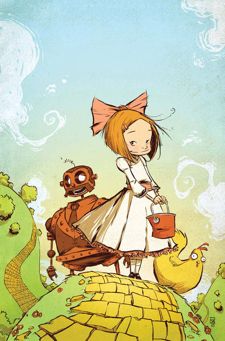Welcome to Wednesday Comics Pull-List, here on Tor.com! Every week we post reviews of a select handful of this week’s comic releases. From those reviews, we let you know what we would pull for keeps.
This week’s batch includes:
- Baltimore: The Plague Ships #4 (of 5)
- Batman & Robin #16
- DV8: Gods & Monsters #8 (of 8)
- Generation Hope #1
- House of Mystery #31
- Invincible #75
- Ozma of Oz #1 (of 8)
- Scarlet #3
- Superboy #1
It also includes our very first three-way review, as all of us were separately intrigued by Brian Michael Bendis and Alex Maleev’s new crime series Scarlet. The reviews are listed alpabetically by title, so scroll down to the bottom if you want to read our perspectives on the red-headed cop-killer.
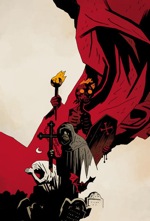 Baltimore: The Plague Ships #4 (of 5)
Baltimore: The Plague Ships #4 (of 5)
Written by Mike Mignola
Art by Christopher Golden
(Dark Horse)
Pull: UGHH, I’m not 100% but I want to say yes. Mignola’s writing sets this above the rest.
Annie says: When I read the first issue of this comic, I was a little suspect about the route it was going to take. Unfortunately, now in its fourth issue, I’m still skeptical. Want to know what you missed in issues two and three? Here you go: Lord Baltimore and Vanessa talk about Lord Baltimore’s first encounter with vampires and, if you couldn’t tell, his experience wasn’t so good. Then Vanessa and Lord Baltimore get on a boat, the boat encounters a massive storm and they end up shipwrecked on an island known as the Furiani Graveyard. It is certainly not looking promising for our characters.
Especially since, in this issue, Vanessa and Lord Baltimore basically sit around on the island, talk about the likelihood of rescue, and briefly touch upon the fact Vanessa doesn’t believe her grandmother’s superstitions. Starting off this way is sort of bland until we dig further into Baltimore’s past, though I am beginning to believe Vanessa is some kind of masochist because she is always engaging him in these long-winded stories. In this issue we find out all about Lord Baltimore’s wife, Elowen; how they met and the suffering they went through together because of the plague. All of Baltimore’s relatives were killed but he didn’t find out about it until after the war. This sends Baltimore into a deep depression that Elowen cannot drag him out of. A slew of doctors come to Baltimore’s estate but only one stands out to Baltimore. This doctor has a gigantic scar down the side of his face and by the time Baltimore straps on his wooden leg and grabs his sword, it’s too late. Haigus initiates the war with Baltimore that he had promised in prior issues and takes Elowen’s life. Just as things start to get interesting, though, the issue ends.
I am still unsure about this comic, which is complicated considering it’s the fourth issue out of five. Mignola is an unbelievable storyteller so when Baltimore does go off on a rant it’s haunting and well detailed and heartbreaking. But, four issues and no real advancement in the overall story is frustrating. Then again, it just sets up the last issue to be an epic battle scene. Hopefully.
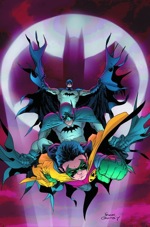 Batman & Robin #16
Batman & Robin #16
Written by Grant Morrison
Artwork by Cameron Stewart
(DC Comics)
Pull: Yes. Duh.
Annie says: Before we begin I should note that Batman & Robin #15 absolutely blew my mind.
This morning I got a message from a friend of mine asking for a time where we could have a “chat about the big reveal” in Batman & Robin #16. This was before I had gotten a chance to read it and seeing as how we all know where this series is headed (Batman Inc.) issue #16 had to be epic in its own right. It was. My brain basically exploded all over again.
It’s necessary in this arena to first compliment Morrison on the writing of this issue because it could have gotten really confusing. Dick, Damian, and Bruce are in a lot of panels together and Bruce spends a lot of time trying to get caught up with what the hell has been going on since he got lost in time. Perhaps the best line of this issue:
“What did I say to you [Dick] about wearing that costume? What is it? What’s up?”
Mr. Morrison, if by any freak chance you read this, thank you for throwing those lines in there. It was important to me, as a fan and a reader, to know that initially Batman (Bruce Wayne) wasn’t going to be entirely kosher with this whole idea. He’s essentially been replaced. (I know…he hasn’t really been replaced because he’s Bruce Wayne and Dick did such a great job carrying on the Batman name, etc.) My second favorite part of this exchange was that it was occurring while all three of them were taking down Dr. Hurt’s 99 henchmen. As Bruce is asking questions, Damian is doing back flips and Dick is breaking people’s arms. The pairing of words and artwork in this issue are perfectly matched. Everything you think Batman is capable of, he is; now two-fold and Stewart’s ability to show not only the difference between the two identically dressed Batmen but his details also high light the admiration that the three individuals have for each other.
This is without mentioning any of the rest of the crazy stuff that happens in this issue: Dr. Hurt and Ozzy Osbourne have something in common, Professor Pyg gets way creepier and remarkably the Joker ends up playing a hero. I’m still not exactly sold on the whole Batman Incorporated thing but, if there was ever a way to lead into it, this would be it.
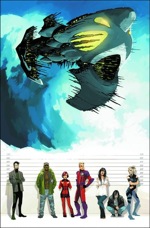 DV8: Gods & Monsters #8 (of 8)
DV8: Gods & Monsters #8 (of 8)
Written by Brian Wood
Art by Rebekah Isaacs
(DC Comics / Wildstorm)
Pull: Yes.
Chris says: My first reaction upon finishing this comic was a petulant desire for more. “The End”? Not good enough! This comic is too engaging to just end. I mean, I haven’t even read the first seven issues of this mini-series, and yet writer Brian Wood and artist Rebekah Isaacs have managed to suck me in completely.
I feel like this issue should be given to aspiring comic creators as a primer. Writers and artists, this is how you pare a story down to its strongest elements while still working within the confines of past title continuity and without alienating a new reader.
I’m getting borderline hyperbolic here, so I should clarify: DV8 #8 isn’t a medium-shattering work. It’s not breaking new ground, changing status quo, or telling a story that hasn’t been told before. What it is doing is telling the best and clearest story possible with the elements that it has to work with. And it works slendidly. I didn’t care about any of these characters before picking up this issue, and now I’m completely invested. Give this issue a shot.
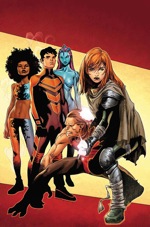 Generation Hope #1
Generation Hope #1
Written by Kieron Gillen
Art by Salvador Espin
(Marvel Comics)
Pull: Don’t bother; you’ve seen it all before, and it was better the first time. Re-read your Claremont X-Men books. And Akira.
Matt says: Let’s admit, right up front, that it’s very hard to do something new with the X-Universe, and especially hard to do something new with X-teens. The CW-style teen drama; the coming-of-age-with-powers character arcs; the monster-of-the-month plotlines written to show the way a group of strangers slowly becomes a new team; and the mutant world politics, complete with continuity so complex it’s not worth trying to keep track of it all; these have all been hallmarks of the X-books since Chris Claremont took them over back in 1975. So if Kieron Gillen and Salvador Espin have an uphill battle, we can try and cut them a bit of slack. That said, it would be nice if there were any indication at all that Gillen and Espin were even trying to break new ground. Instead, Generation Hope begins as a mélange of recycled homages-cum-clichés, complete with an overwritten series of internal monologues to carry us through the issue.
In issue #1, we are (re-)introduced to Hope Summers—mutant messiah in the making—and the “Five Lights.” (A catchy name for a pop group, yeah?) The “Five Lights” are five new mutants (the first new mutants since the Scarlet Witch’s “No more mutants” decree five years ago), whose powers have manifested a little…wonkily. Each mutant manifests unable to control his or her powers, until Hope finds them and touches them. (So, you know—in order for these new mutants to bring the future of mutantkind, they have to be touched by Hope. Cute, right?) At the start of issue #1, Hope has found and touched four of the five new mutants: Gabriel, who has super-speed—though, alas, this means he’s aging at a faster rate—and uses humor to cover up his insecurities. Which, yes, is just a recycled version of Quicksilver, but who’s counting? Then there’s Laurie, whose “skin is shifting crystal”; she’s intelligent (but not unnaturally so—she just works very hard), and she can fly. Think “Emma Frost, made to look a bit more like Apocalypse or Mystique.” Next we’ve got Idie, who can control flames with her right side, and ice with her left; Iceman+Pyro as a young woman from Africa (but…you know…not Storm). Finally, there’s Teon, a beast-man with a beast-like intellect; or, as you’ll probably come to think of him, Sabretooth without the interesting personality or healing factor (or Dog, from The Age of Apocalypse?). These four are led by Hope: a red-headed mutant powerhouse with a not-fully-explained power set who grew up in the future. You know, kind of like Rachel Summers.
So with our cast of recycled X-tropes in place, this month our heroes set out to rendezvous with the Fifth Light: Uedo Kenji, a Japanese artist who has been turning into Tetsuo from Akira. You think that this is me making another joke, but it’s not. The last four pages of the issue are a deliberate homage to Otomo’s work. I love a good homage—but it would be nice to see something a little less cliché. Given a Japanese mutant, it is as if Gillen and company were so desperate to find something other than previous X-Men to recycle that they simply grabbed onto the first Japanese sci-fi mutant they could find. The blatantly-expository first issue is carried along, as I’ve mentioned, by an overwritten series of internal monologues; each “Light” in turn gets a chance to ramble on about him- or herself—and so, naturally, each monologue begins with some variation on the sentence, “I am a light.” As with most voice-over narrative, the exposition we get isn’t nearly as vital as the author thinks it is; try reading this issue and ignoring the text boxes, and it’s immediately half as boring (almost entertaining, in fact).
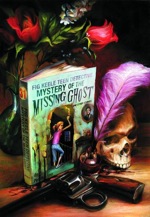 House of Mystery #31
House of Mystery #31
Written by Matthew Sturges
Art by Werther Dell-Edera
(DC Comics / Vertigo)
Pull: I want to say yes, but can’t.
Chris says: I first checked out House of Mystery a few months ago, when it was in the middle of an arc, and found it too difficult to latch onto. Today’s issue #31 is a kick-off story for a new arc and is geared much more to new readers. (There’s even an introductory page that brings new folks up to speed on the concept and characters, which I greatly appreciated.)
Knowing the dramatic relationships between the characters and their world(s) didn’t completely dispel my unease with this title, however. Writer Matthew Sturges addresses part of this himself in the issue:
If you’re reading these words and rolling your eyes, thinking, “Dear God, what a lot of maudlin, self-pitying crap,” then this isn’t the book for you.
To be honest, I was half-thinking that. Sturges addresses the reader directly in running caption boxes in this issue, kicking off with, “This goes out to the broken ones,” and continuing in that vein up to the end of the book. While it’s debatable as to whether this is maudlin crap as Sturges claims, it doesn’t help that the running commentary doesn’t really match the action in this issue. The characters don’t feel irretrievably broken in this issue. If anything, they seem to be rallying. One group even decides to enact what I imagine will be a series-closing plan.
This issue’s mini-story is better integrated into the main arc, as well, and the idea of a supernaturally-themed Encyclopedia Brown-type story is a great one. (I would love to see this as a series, actually.)
And yet, this series is unable to fully get a grip on me as a reader. Now that I’ve been able to gain entry into its mythos, I feel like I have a clearer grip on just why House of Mystery isn’t appealing to me: the art.
Werther Dell’Edera draws in a style that’s very common to Vertigo titles. Everything is realistically proportioned and straightforward, with clean lines and staging that isn’t meant to be flashy. If you’ve read Fables, Y: The Last Man, or The Unwritten, then you’ve seen this style before. Thing is, I don’t think that style works for a title like House of Mystery. The lack of detail in the art kept me apart from the fantasy in the story and made it difficult to differentiate between characters.
Ultimately, while I’m really excited by the elements of the story in House of Mystery, they don’t quite add up to a cohesive whole.
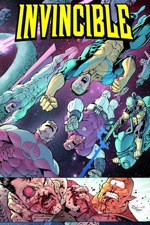 Invincible #75
Invincible #75
Written by Robert Kirkman
Pencils by Ryan Ottley
(Image Comics)
Pull: Yes. You’ve waited three months for it—now savor the epic battle!
Matt says: The Viltrumite War heats up in the milestone 75th issue of Invincible, back this month after several months of lag. To make up for the wait—and to celebrate the occasion—Kirkman, Ottley, and company serve up 36 pages of Invincible, and package it with two backup features: chapters of Science Dog and Tech Jacket. The price-point jumps, too—you’ll shell out 6 bucks for this issue—but Invincible fans should be duly sated after the long wait; this one was worth it. Ottley really gets cinematic here—a lot of the war is told in double-page spreads—and whenever there is a lack of backgrounds (a big fight takes place in the void of space) more than compensates by throwing in more bodies and space debris than you’ll be able to keep track of.
Invincible is billed as “The Best Superhero Book in the Universe!” and, whether this is true or not, the book certainly does try to be all things to all superhero fans. Kirkman has done a nice job over the years of crafting a tale that is largely character-driven, but full of plot as well. Each month (or, at least, each issue…), we see Invincible grapple with the classic moral dilemmas of a super-powered hero, even as he grapples with a cast of foes who are consistently fresh and interesting. (Indeed, with reference to my above review of Generation Hope, we might say: This is a model for how to do something new, even while occasionally recycling from the rich history of your genre!) And while it’s nice to let our hair down a bit and just really sprawl out into a rock-‘em-sock-‘em issue, it is for these reasons that I for one will be happy to see the Viltrumite War end. The “major events” in Invincible tend to be basically talky punch-ups, just quips and violence. And while it’s always well-written quips and beautifully-drawn violence, it is at times like these that Invincible is most like every other superhero book in the universe. Meanwhile, the lead-up to the Viltrumite War has been long, and even a bit episodic (as Nolan and Allen travel around collecting plot coupons, for example…). In issue 75 we’re finally getting the long-awaited payoff, but it will be nice to see Invincible finally get back to the character-driven stories that really set it apart.
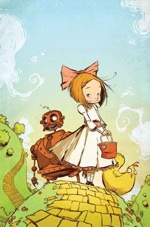 Ozma of Oz #1 (of 8)
Ozma of Oz #1 (of 8)
Adaptation written by Eric Shanower
Art by Skottie Young
(Marvel Comics)
Pull: Absolutely.
Chris says: The first time I encountered artist Skottie Young, he was still new to Marvel Comics and somewhat untested. He had been given a one-shot comic to draw, an Astonishing X-Men/Runaways special for Free Comic Book Day. Being a fan of both titles at the time, I picked it up…
…and absolutely hated it. I was used to artists like John Cassaday and Adrian Alphona and Young’s cartoony scribble was an affront to that. In today’s release of Ozma of Oz #1, the continuation of Marvel Comics’ Oz series adaptations (Tor.com’s own Mari Ness rereads the book itself here.) Young and I meet once again.
Whomever took Young off of superhero comics and put him on this is a genius. (Editor Nathan Cosby, perhaps?) This book looks amazing and Young balances the cutesy-poo side of the Baum books expertly with its more terrifying elements. The exchange in this issue between Dorothy and Billina the hen is very lively and funny. Oh, and the Wheelers? Extremely scary.
Eric Shanower’s adaptation is light and clear without sacrificing or criticizing the more out-of-date elements of Baum’s text. (Dorothy has an opinion on everything and seemingly no patience for the perspective of others.) Skottie Young’s art is panoramic while remaining intimate and fun. These two won an Eisner for their adaptation of The Wizard of Oz and that quality continues here.
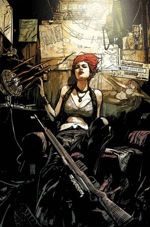 Scarlet #3
Scarlet #3
Written by Brian Michael Bendis
Art by Alex Maleev
(Marvel / Icon)
Pull: Yes! The revolution is at hand—and it’s never looked better. – Matt
Yes! – Annie
What they said – Chris
Matt says: Bendis and Maleev, I think, are destined to be one of those classic writer/artist teams that populate the history of comics; every time they get together to do a book, they find a new way to impress me. Case in point: Scarlet, the newest creator-owned series from Bendis, now just three issues into its run. For those of you who have missed the first two issues, Scarlet follows the exploits of a young woman whose boyfriend was targeted and killed by a police officer. In trying to figure out what happened, her eyes are opened to the rampant corruption of the police force—cops with drug habits, cops selling drugs, cops blackmailing other cops, etc., and all of it given the official blind-eye by the rest of the force. By the time she’s taken revenge on her boyfriend’s actual killer, then, Scarlet has already taken up a new path in life: lead the fight against corruption, and help the Little People take back the streets.
Bendis has long enjoyed first-person voice-over narration, but in Scarlet he takes it to the logical next step: Scarlet regularly breaks the fourth wall, speaking directly to the readers. Not only does she attempt to explain (and justify) her actions to us, but—more interesting still—she asks us to be her accomplices in these acts, trying to pull us into the revolution she’s starting. The book reads like an explosive short-circuit: a vigilante comic book tale has crossed wires with a counterculture manifesto, and every page finds Scarlet waging a war on two fronts, both for the streets of Portland and for the hearts and minds of her readers.
As a Brian Bendis true crime comic (and a Bendis/Maleev product), Scarlet is already a soaring success. As a counterculture manifesto, I’m so far less convinced. Scarlet seems to feed us the standard conservative line: bad things happen because of corruption, the natural order has been perverted, and we simply need to get the bad apples out of the barrel. This is a great basis for a comic book story, as it allows her to vent her anger on targets who deserve her vengeance—Scarlet can simply spend the series weeding out the bad apples, and we’ll willingly come along for the ride. But as a political manifesto, it seems to obscure the more important question: what if the greed and compromise isn’t a sign of corruption, but is instead the system itself? What happens if the bad things aren’t a sign of the natural order being perverted, but are instead the natural order itself? What happens if it’s not simply a matter of removing the bad apples, but of planting new seeds? At some point, Bendis’s political manifesto is going to have to choose between action-hero vigilantism and counterculture anarchism. Until then, it’s a productive tension that drives the book—and one that Maleev makes sure is as much fun to look at as it is to read!
Annie says: A long time ago, when Chris used to do these reviews on his own, he read the first issue of Scarlet and wasn’t sure whether or not he’d like the rest of the series. Since then, Chris has hopped on board and it’s safe to say I have as well.
At first glance I thought this comic was going to be a lot different than it was. In the first two pages she goes on a tangent about love and happiness and how these are the things she’s fighting for. Not just her though, “we” as in everyone. Similar to Chris’s review, Scarlet continues to address the reader directly in this issue; a concept that I really like. Bendis does a fantastic job of making it a point to put both the reader and Scarlet on the same emotional level. I think that by being so honest with her words we’re getting into the story in a way we don’t often experience.
“Everyone in the world should have the possibility for this [love and happiness]. And yes, of course there’s tragedy in the world and of course there’s pain. It’s part of the human condition.”
Scarlet’s main gripe isn’t that the world is unfair and that bad things shouldn’t happen but rather that individuals who disrupt the natural order of things do not hold a place in the world she wants to create. I can’t say that I disagree with her either, which certainly calls into question my capability of defining what is ultimately right and wrong.
The artwork is a little reminiscent of Insane Jane with less stock footage and fewer collages. I like the surreal nature of it because it adds to the elements of extremism that Scarlet embodies. There really isn’t anything wrong with this comic except for the fact that it’s a little too short for my taste (only 24 pages—the rest of the comic is a series of interviews and email responses from Bendis to fans) but it definitely has me looking forward to the next issue.
Chris says: I have some worries regarding the story in Scarlet; ones that crystalized a little further with this most recent issue. My first is that this title will become yet-another-vigilante-title. The main character in this book straddles a fine line between personalized and politicized revenge. How soon before she starts killing people who don’t agree with her but don’t actively harm her? She’s already somewhat crossed that line. Her anti-corruption stance means less and less the more violent and intimidating her tactics get.
That question brings me to a bigger one. Namely, where is this book going? Does Scarlet go too far? It would seem impossible for her not to. When is her comeuppance due? And will she be able to accomplish anything real before she is out of the picture?
In this latest issue, Scarlet assembles a wider message about her beliefs in society, with the intention of taking it public. But this development seems to be ignoring the insular nature of her viewpoint. Scarlet kills people in the name of weeding out corruption, but that doesn’t mean others will be pushed take such a drastic action. (Honestly, I don’t want to ever meet the kind of person who is pushed to do so.)
The story in Scarlet doesn’t seem like it has a lot of places to go once the excitement of her situation recedes. But it’s still early yet, and the book is so well done that there’s a good chance Bendis and Maleev will be able to take this kind of story to some unexpected heights.
Superboy #1
Written by Jeff Lemire
Art by Pier Gallo
(DC Comics)
Pull: Don’t bother. Whether you’re a longtime fan or completely new to the character, this book is only going to disappoint. Instead, either dig into the classic tales of Superboy, or pull out those first few seasons of Smallville.
Matt says: The first issue of Superboy is obviously written with new readers in mind. Don’t know who Superboy is (and/or which version of Superboy we’re dealing with)? No problem—Connor Kent will spend the first few pages narrating out some blatant exposition (all of which, meanwhile, you could get simply from reading the logo at the bottom of page 3…). Want to know what his powers are, and how they work? No problem—we’ve got a simple monster-of-the-day storyline in issue #1, just to show you how everything works. And of course, along the way we get to meet the other major players in the cast—each of them excruciatingly introduced by Connor’s voice-over narration.
But if this first issue bends over backward to target the new reader, one who has no history with Connor Kent and his supporting cast, then it would seem that it fails on one major point: in and among all of the exposition, writer Jeff Lemire never quite gets around to giving us a reason to care about Connor Kent and his exploits. With returning readers, you could take a bit of this for granted—there are Superboy fans out there, after all, who are already emotionally invested in the character. But with new readers, who aren’t yet in love with the very idea of the character, there needs to be something to hook us in. The overly-simple plot and overly-meticulous exposition of issue #1 will certainly bore Superboy fans, even as it fails to give the new readers any reason to stick around. Worse yet, Lemire seems to have a hard time finding his tone on the book; the first few pages are overly pulpy, and then the tone abruptly shifts to teen-drama as Connor heads to school. The final fight settles into the “cliché comic book tone” (complete with repartee between Superboy and his villain, and the sideline commentary of the non-powered friend-of-the-hero) that I suspect will become the book’s standard feel.
Pier Gallo does a professional job on the art (with the sole exception of an awful, gimmicky layout on page 7), though his spotlight is completely stolen by Rafael Albuquerque’s cover. The cover image is iconic and exciting; it does a perfect job of convincing the non-Superboy reader that there’s something worth checking out inside. Alas, this puts Gallo in the almost-impossible position of attempting to maintain that excitement—and by contrast his art feels a little disappointing, even as Lemire’s words sap the rest of the energy out of the book.
Chris Greenland also got A Shepherd’s Tale and is interested to see what Richard Fife says about it.
Annie Gala would be into gaining some roots as long as she could avoid perspective.
When Matt Lampert isn’t writing about comics, he’s a philosophy professor in New York City.










